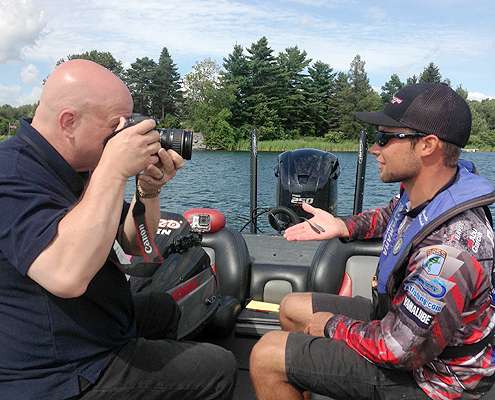
The biggest key to winning the St. Lawrence River Elite Series tournament was finding better than average smallmouth bass. When you consider that the average smallmouth in these waters is heftier than just about anywhere else in the country, that’s saying something.
How did Palaniuk, who had never fished here before and who had no help whatsoever, manage to find the biggest ones? On the Sunday evening before Monday’s first official practice day, Palaniuk spread six contour maps of the St. Lawrence River and Lake Ontario out on the bed and floor of his motel room.
“I just looked for the largest spawning areas near deep water and the best smallmouth habitat,” Palaniuk said.
That area included the water outside Henderson and Chaumont bays off Lake Ontario. Palaniuk was undaunted that these places were more than 100 miles from Waddington, N.Y., where the weigh-in was to happen.
It didn’t take Palaniuk long during Monday’s practice to learn that he had made a wise decision. He found the bass on points and steep drops near those points in 20 to 35 feet of water.
For some reason, he didn’t notice many bass on his Lowrance graph in the down scanning mode while idling over these structures. However, when he tooled around with his electric motor, he could see the bass on his bow Lowrance graph set on 2D sonar. To help him spot individual smallmouths near the bottom, Palaniuk set the graph on 2X bottom scan mode.
“The bass were relating to sand and gravel seams on some spots and to boulders on others,” Palaniuk said. “The wind was pushing balls of baitfish up over the points. That’s what the bass were feeding on.”
Dialing In
 Finding big smallmouth bass is one thing. Catching them is another. Palaniuk duped 88 pounds, 12 ounces of brown bass with Clear Silver Shiner and Green Pumpkin color Berkley PowerBait Twitchtail Minnows soaked in Berkley Gulp Alive Recharge Liquid.
Finding big smallmouth bass is one thing. Catching them is another. Palaniuk duped 88 pounds, 12 ounces of brown bass with Clear Silver Shiner and Green Pumpkin color Berkley PowerBait Twitchtail Minnows soaked in Berkley Gulp Alive Recharge Liquid.
He rigged this slight, 3-inch baitfish imitator 12 inches above a 3/8-ounce drop shot weight on a 6-pound Trilene 100% Fluorocarbon leader knotted to 8-pound Fireline. A 6-foot, 10-inch Fenwick Elite Tech spinning rod and an Abu Garcia Revo Premier size 20 spinning reel subdued the monster bass.
Many Elite Series pros didn’t believe it was necessary to drop down to 6-pound line to catch these northern smallmouth bass. Palaniuk thinks otherwise.
“The light line lets the bait move with a more natural action,” Palaniuk said. “And I don’t want the bass to notice my line when I drop a bait in front of them.”
Palaniuk made short 10- to 15-foot pitches, let the drop shot weight sink to the bottom and moved his boat up to the bait. He kept his eyes continually glued to his graph. Whenever he spotted a fish on the graph, he would drop his bait down directly to it. He often had to quickly reel in to do this.
“I caught 90 percent of my bass after I first saw them on my graph,” Palaniuk said. “They were typically 2 to 3 feet above the bottom.”
Palaniuk often watched a bass on his graph move up to his bait as is was sinking and then followed it to the bottom. Whenever that happened, a strike was almost sure to follow.
To ensure that his bait sank quickly to the bass, Palaniuk would hold the handle of his rod up out in front of his face and point the rod tip almost straight down at the water. This prevented the wind from bagging the line and stalling the bait’s fall.
Six of the seven points that Palaniuk fished during the four-day event produced the bass that comprised his enormous catch. He started on the same point the first three days. It was slow pickings there on Day 3 when Palaniuk’s boat was bouncing on 3- to 4-foot waves. His trolling motor leaped out of the water on nearly every wave.
With only a few bass in his livewell, Palaniuk moved to a spot closer to Henderson Bay. There he finished his limit and culled some smaller bass. This was the move that clinched the tournament.
Palaniuk started on the same spot on the final day and boated well over 20 pounds of bass in the first 90 minutes of fishing there. He culled only one of those bass before making the long run back to Waddington with far more weight than he needed for the victory.





